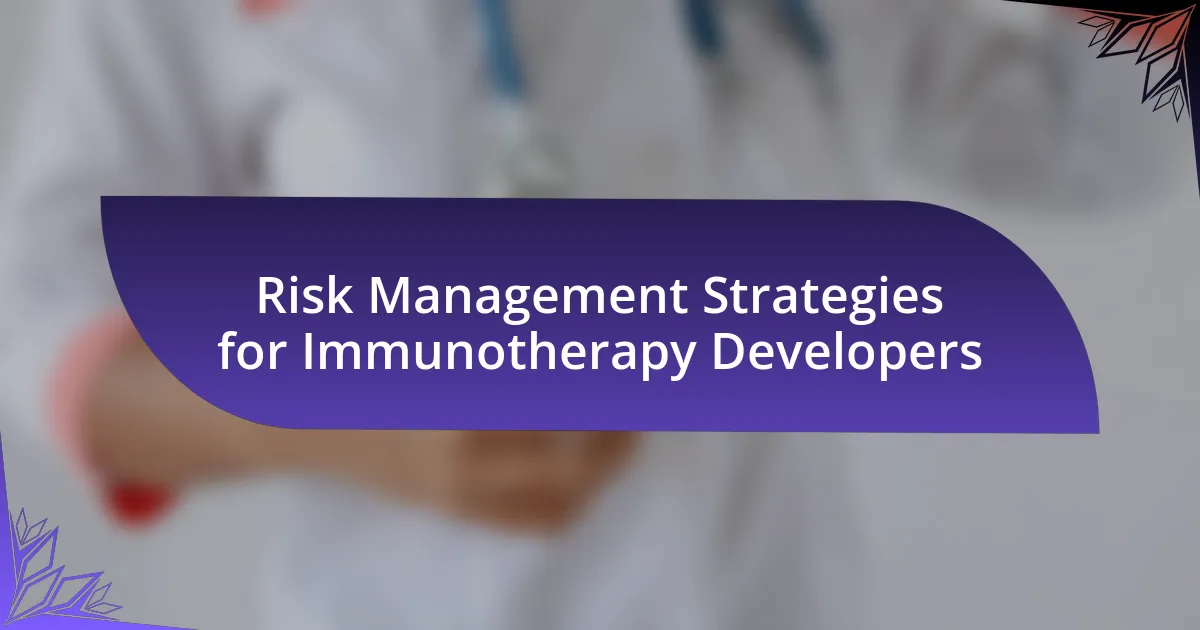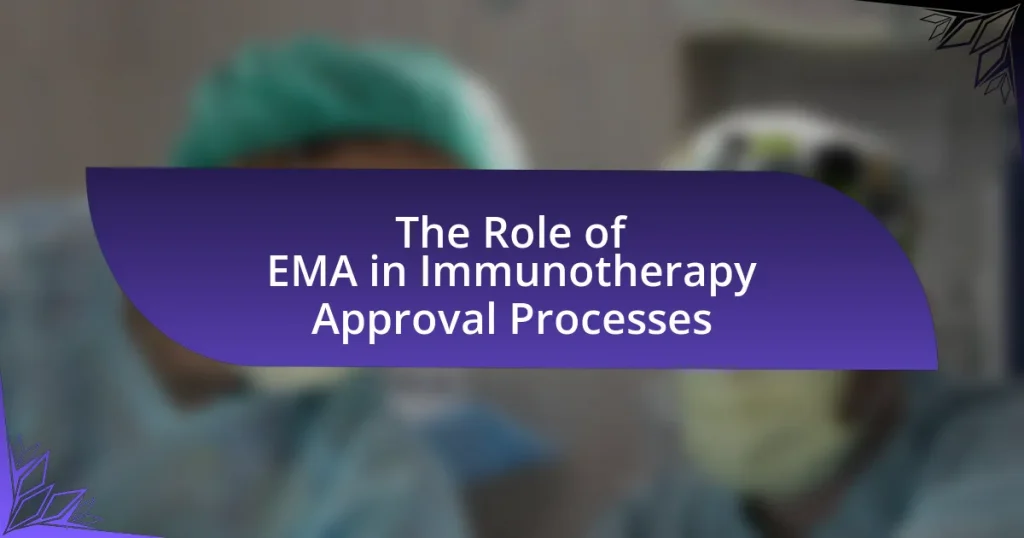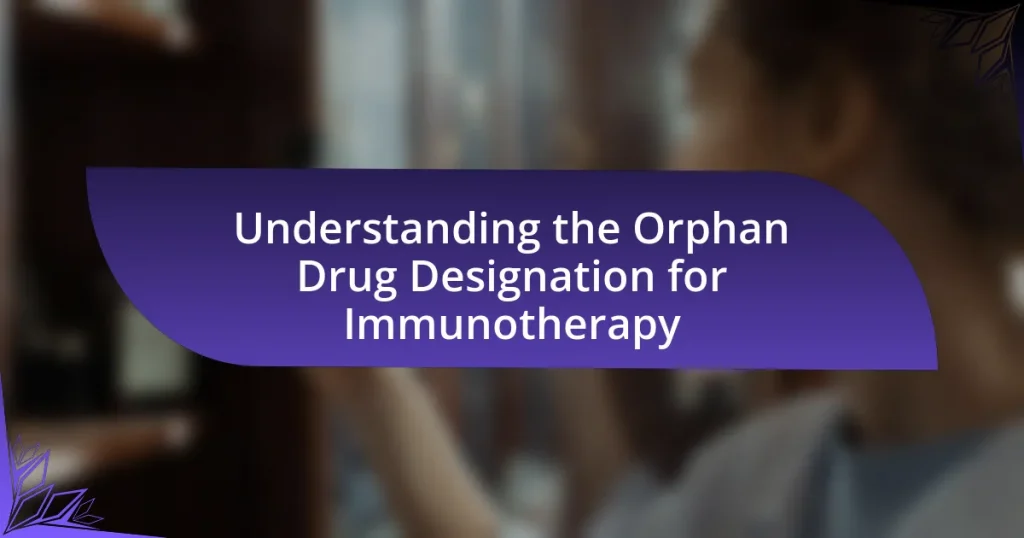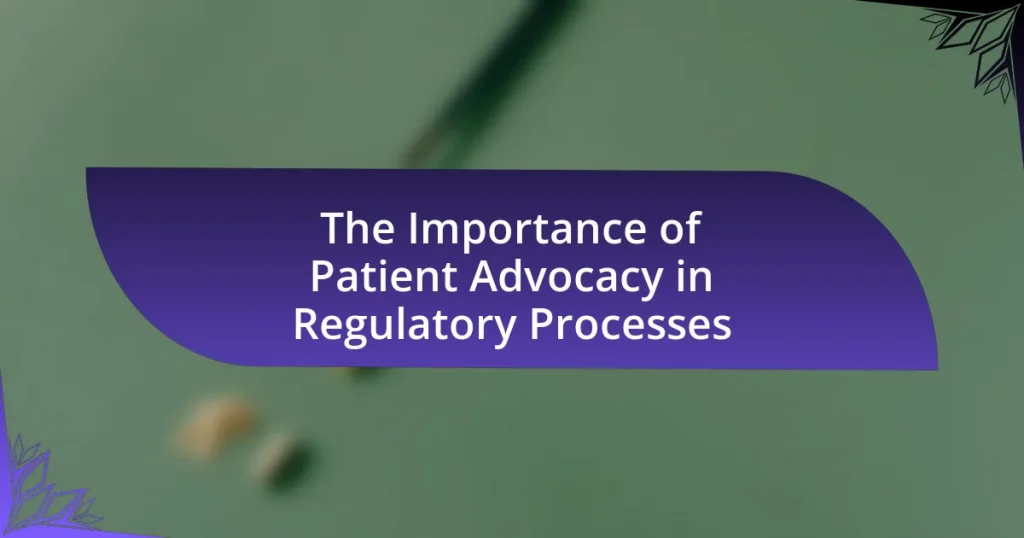Risk management strategies for immunotherapy developers are critical for navigating the complexities of clinical trials, regulatory compliance, and stakeholder engagement. Key components include comprehensive clinical trial design, proactive risk assessment, and continuous monitoring to enhance patient safety and treatment efficacy. Developers face specific risks such as regulatory challenges, high costs, and uncertain clinical outcomes, necessitating robust strategies to mitigate these issues. Effective risk management not only improves project outcomes but also fosters a culture of accountability and informed decision-making, ultimately accelerating the delivery of safe and effective immunotherapies to patients.
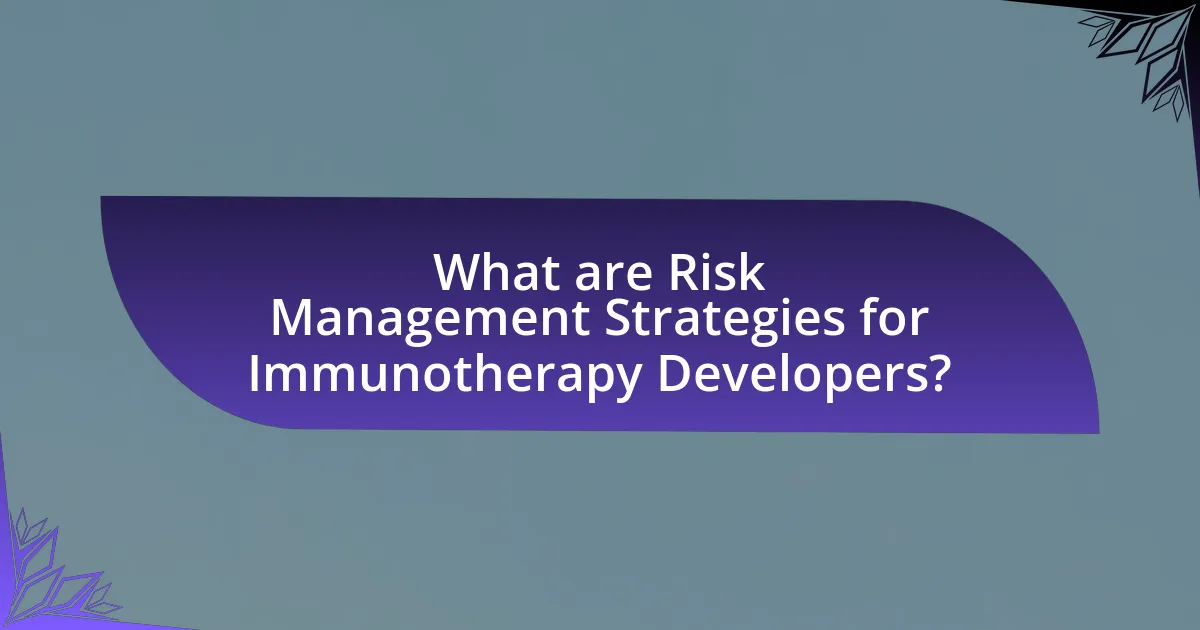
What are Risk Management Strategies for Immunotherapy Developers?
Risk management strategies for immunotherapy developers include comprehensive clinical trial design, robust regulatory compliance, and proactive stakeholder engagement. Comprehensive clinical trial design involves identifying potential risks early, utilizing adaptive trial designs to mitigate unforeseen challenges, and ensuring diverse patient populations to enhance data reliability. Robust regulatory compliance requires staying updated with evolving guidelines from agencies like the FDA and EMA, which helps in anticipating regulatory hurdles. Proactive stakeholder engagement involves maintaining transparent communication with investors, healthcare providers, and patients to manage expectations and foster trust. These strategies are essential as they help in minimizing financial losses and enhancing the likelihood of successful product development in a highly competitive and regulated environment.
Why is risk management crucial in immunotherapy development?
Risk management is crucial in immunotherapy development because it helps identify, assess, and mitigate potential risks that could impact the safety and efficacy of treatments. The complexity of immunotherapy, which often involves novel approaches and biological agents, increases the likelihood of unforeseen adverse effects and regulatory challenges. For instance, clinical trials have shown that adverse immune responses can lead to severe side effects, necessitating robust risk management strategies to ensure patient safety and compliance with regulatory standards. By implementing effective risk management, developers can enhance the likelihood of successful outcomes, optimize resource allocation, and ultimately accelerate the delivery of safe and effective immunotherapies to patients.
What specific risks do immunotherapy developers face?
Immunotherapy developers face several specific risks, including regulatory challenges, high development costs, and uncertain clinical outcomes. Regulatory challenges arise from the complex approval processes required by agencies like the FDA, which can delay product launches and increase costs. High development costs are significant, with estimates suggesting that developing a new cancer immunotherapy can exceed $1 billion, creating financial strain on companies. Uncertain clinical outcomes pose a risk as many immunotherapies fail to demonstrate efficacy in clinical trials, leading to potential financial losses and wasted resources. These risks highlight the need for robust risk management strategies in the immunotherapy development process.
How can effective risk management improve project outcomes?
Effective risk management can significantly improve project outcomes by identifying, assessing, and mitigating potential risks throughout the project lifecycle. By proactively addressing risks, project teams can minimize disruptions, reduce costs, and enhance the likelihood of meeting project objectives. For instance, a study published in the Project Management Journal found that projects with robust risk management practices are 30% more likely to succeed in achieving their goals compared to those without such practices. This demonstrates that effective risk management not only safeguards resources but also fosters a culture of accountability and informed decision-making, ultimately leading to more successful project outcomes.
What are the key components of risk management strategies?
The key components of risk management strategies include risk identification, risk assessment, risk mitigation, risk monitoring, and risk communication. Risk identification involves recognizing potential risks that could impact the project, while risk assessment evaluates the likelihood and impact of these risks. Risk mitigation focuses on developing strategies to minimize or eliminate identified risks. Risk monitoring ensures ongoing evaluation of risks and the effectiveness of mitigation strategies. Finally, risk communication involves sharing information about risks and strategies with stakeholders to ensure transparency and informed decision-making. These components are essential for effectively managing uncertainties in immunotherapy development, where clinical trials and regulatory approvals present significant challenges.
How do risk assessment and analysis contribute to strategy formulation?
Risk assessment and analysis are critical components in the formulation of strategies for immunotherapy developers. They enable organizations to identify potential risks associated with clinical trials, regulatory compliance, and market entry, allowing for informed decision-making. By systematically evaluating the likelihood and impact of various risks, developers can prioritize their resources and efforts effectively. For instance, a study published in the Journal of Clinical Oncology highlights that risk analysis can lead to a 30% reduction in trial failures by addressing key uncertainties early in the development process. This proactive approach not only enhances the likelihood of successful outcomes but also aligns strategic initiatives with the overall risk profile of the organization.
What role does stakeholder engagement play in risk management?
Stakeholder engagement is crucial in risk management as it facilitates the identification, assessment, and mitigation of risks through collaborative input. Engaging stakeholders, such as patients, healthcare providers, and regulatory bodies, ensures that diverse perspectives are considered, leading to a more comprehensive understanding of potential risks associated with immunotherapy development. For instance, a study published in the Journal of Clinical Oncology highlighted that involving patients in the decision-making process improved the identification of risks related to treatment side effects and patient adherence. This collaborative approach not only enhances risk management strategies but also fosters trust and transparency among stakeholders, ultimately contributing to the success of immunotherapy initiatives.
What methodologies are commonly used in risk management for immunotherapy?
Common methodologies used in risk management for immunotherapy include quantitative risk assessment, qualitative risk assessment, and risk mitigation strategies. Quantitative risk assessment employs statistical models to evaluate the likelihood and impact of adverse events, allowing developers to prioritize risks based on numerical data. Qualitative risk assessment involves expert judgment and stakeholder input to identify and categorize risks based on their potential effects and likelihood. Risk mitigation strategies focus on implementing measures to reduce identified risks, such as modifying treatment protocols or enhancing patient monitoring. These methodologies are essential for ensuring patient safety and optimizing therapeutic outcomes in immunotherapy development.
How does the Failure Mode and Effects Analysis (FMEA) apply to immunotherapy?
Failure Mode and Effects Analysis (FMEA) applies to immunotherapy by systematically identifying potential failure modes in the development and administration of immunotherapeutic agents, assessing their effects on patient safety and treatment efficacy. FMEA enables developers to prioritize risks based on their severity, occurrence, and detectability, facilitating targeted interventions to mitigate these risks. For instance, in a study published in the Journal of Immunotherapy, researchers demonstrated that applying FMEA to the manufacturing process of CAR-T cell therapies significantly reduced the incidence of adverse events by addressing critical failure points in the production and quality control stages. This structured approach enhances the overall safety profile of immunotherapy treatments, ensuring better patient outcomes.
What is the significance of Monte Carlo simulations in risk assessment?
Monte Carlo simulations are significant in risk assessment as they provide a quantitative method for evaluating the impact of uncertainty in decision-making processes. By generating a range of possible outcomes based on probabilistic inputs, these simulations allow risk managers to understand potential risks and their implications more comprehensively. For instance, in the context of immunotherapy development, Monte Carlo simulations can model various scenarios related to clinical trial outcomes, regulatory approvals, and market dynamics, enabling developers to make informed decisions. This approach is validated by studies showing that organizations employing Monte Carlo methods in risk assessment can achieve better project outcomes and resource allocation, as evidenced by a report from the Project Management Institute, which highlights improved risk management practices in over 70% of organizations that utilize these simulations.
How can immunotherapy developers implement risk management strategies effectively?
Immunotherapy developers can implement risk management strategies effectively by conducting thorough risk assessments and establishing robust monitoring systems. These assessments should identify potential risks associated with clinical trials, including patient safety, regulatory compliance, and market acceptance. For instance, the FDA emphasizes the importance of risk evaluation and mitigation strategies (REMS) to ensure patient safety during drug development. Additionally, developers should utilize data analytics to monitor adverse events in real-time, allowing for timely interventions. A study published in the Journal of Clinical Oncology highlights that proactive risk management can reduce trial failures by up to 30%, demonstrating the effectiveness of these strategies in improving outcomes.
What steps should be taken to create a risk management plan?
To create a risk management plan, the following steps should be taken: identify risks, assess risks, develop risk mitigation strategies, implement the strategies, and monitor and review the plan.
Identifying risks involves recognizing potential issues that could impact the project, such as regulatory changes or clinical trial failures. Assessing risks requires evaluating the likelihood and impact of each identified risk, often using qualitative or quantitative methods. Developing risk mitigation strategies entails creating actionable plans to minimize the impact of risks, which may include contingency plans or alternative approaches. Implementing the strategies involves executing the plans and ensuring that all stakeholders are aware of their roles. Finally, monitoring and reviewing the plan is essential to adapt to new risks and evaluate the effectiveness of the strategies over time.
These steps are crucial for immunotherapy developers, as they navigate complex regulatory environments and scientific uncertainties, ensuring that potential risks are managed effectively to enhance project success.
How can continuous monitoring and review enhance risk management efforts?
Continuous monitoring and review enhance risk management efforts by providing real-time insights into potential risks and enabling timely interventions. This proactive approach allows organizations to identify emerging threats, assess their impact, and adjust strategies accordingly. For instance, a study published in the Journal of Risk Management highlighted that companies employing continuous monitoring reported a 30% reduction in risk-related incidents compared to those using traditional methods. By integrating data analytics and feedback loops, continuous monitoring ensures that risk management practices remain relevant and effective in the face of evolving challenges.
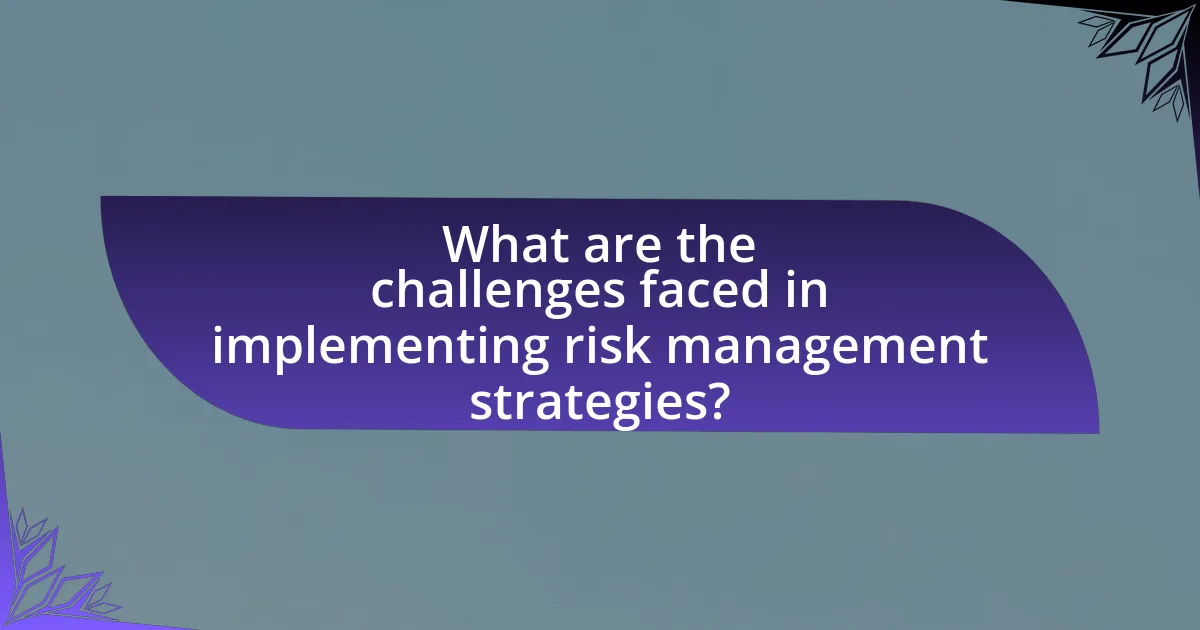
What are the challenges faced in implementing risk management strategies?
The challenges faced in implementing risk management strategies include regulatory compliance, resource allocation, and stakeholder engagement. Regulatory compliance is complex due to the evolving nature of immunotherapy regulations, which can lead to delays and increased costs. Resource allocation is often constrained, as developers must balance funding between research, development, and risk management efforts. Stakeholder engagement is critical, as differing priorities among investors, regulatory bodies, and clinical partners can complicate consensus on risk management approaches. These challenges are supported by industry reports indicating that 70% of immunotherapy projects face delays due to regulatory hurdles, highlighting the significant impact of these factors on successful implementation.
What common obstacles do developers encounter?
Developers commonly encounter obstacles such as technical challenges, regulatory hurdles, and resource limitations. Technical challenges include issues with software integration and system compatibility, which can impede project progress. Regulatory hurdles often arise from the need to comply with stringent industry standards and guidelines, particularly in fields like immunotherapy, where safety and efficacy are paramount. Resource limitations, including insufficient funding and personnel, can restrict the ability to execute projects effectively. These obstacles are well-documented in industry reports, highlighting their impact on project timelines and success rates in the development of new therapies.
How can resource limitations impact risk management efforts?
Resource limitations can significantly hinder risk management efforts by restricting the availability of necessary tools, personnel, and funding required to identify, assess, and mitigate risks effectively. When resources are scarce, organizations may struggle to conduct comprehensive risk assessments, leading to incomplete data and potentially overlooking critical risks. For instance, a study published in the Journal of Risk Research indicates that companies with limited budgets often prioritize immediate operational needs over long-term risk management strategies, which can result in increased vulnerability to unforeseen challenges. This lack of investment in risk management can ultimately lead to higher costs and greater losses in the event of a crisis, as evidenced by historical cases where inadequate risk planning exacerbated the impact of adverse events.
What strategies can be employed to overcome regulatory challenges?
To overcome regulatory challenges, immunotherapy developers can employ strategies such as proactive engagement with regulatory agencies, thorough understanding of regulatory frameworks, and implementation of robust compliance systems. Proactive engagement involves regular communication with agencies like the FDA or EMA to clarify requirements and expectations, which can facilitate smoother approval processes. A thorough understanding of regulatory frameworks ensures that developers are aware of the specific guidelines and standards applicable to their therapies, reducing the risk of non-compliance. Implementing robust compliance systems, including quality management practices and risk assessment protocols, helps in maintaining adherence to regulations throughout the development process. These strategies are supported by the fact that companies that actively engage with regulators often experience faster approval times, as evidenced by studies showing that early dialogue can lead to more efficient development pathways.
How does organizational culture influence risk management success?
Organizational culture significantly influences risk management success by shaping employee behaviors, decision-making processes, and communication patterns. A strong culture that prioritizes transparency and accountability fosters an environment where risks are openly discussed and addressed, leading to more effective risk management strategies. For instance, organizations with a culture of collaboration and continuous learning are better equipped to identify potential risks early and implement proactive measures. Research by the Institute of Risk Management indicates that organizations with a positive risk culture experience 30% fewer incidents related to risk, demonstrating the direct correlation between culture and risk management outcomes.
What practices can foster a risk-aware culture among teams?
To foster a risk-aware culture among teams, organizations should implement regular risk assessment training and encourage open communication about risks. Regular training sessions equip team members with the skills to identify and evaluate potential risks, while open communication fosters an environment where team members feel comfortable discussing concerns and sharing insights. Research indicates that organizations with a strong risk culture experience 30% fewer incidents related to risk management, highlighting the effectiveness of these practices in promoting awareness and proactive risk management.
How can leadership support effective risk management initiatives?
Leadership can support effective risk management initiatives by fostering a culture of open communication and accountability. By encouraging team members to share insights and concerns regarding potential risks, leadership enhances the identification and assessment of risks, which is crucial in the complex field of immunotherapy development. Research indicates that organizations with strong leadership support for risk management are 30% more likely to successfully mitigate risks, as they prioritize risk assessment in strategic planning and resource allocation. This proactive approach not only minimizes potential setbacks but also aligns risk management with organizational goals, ultimately leading to more successful outcomes in immunotherapy projects.
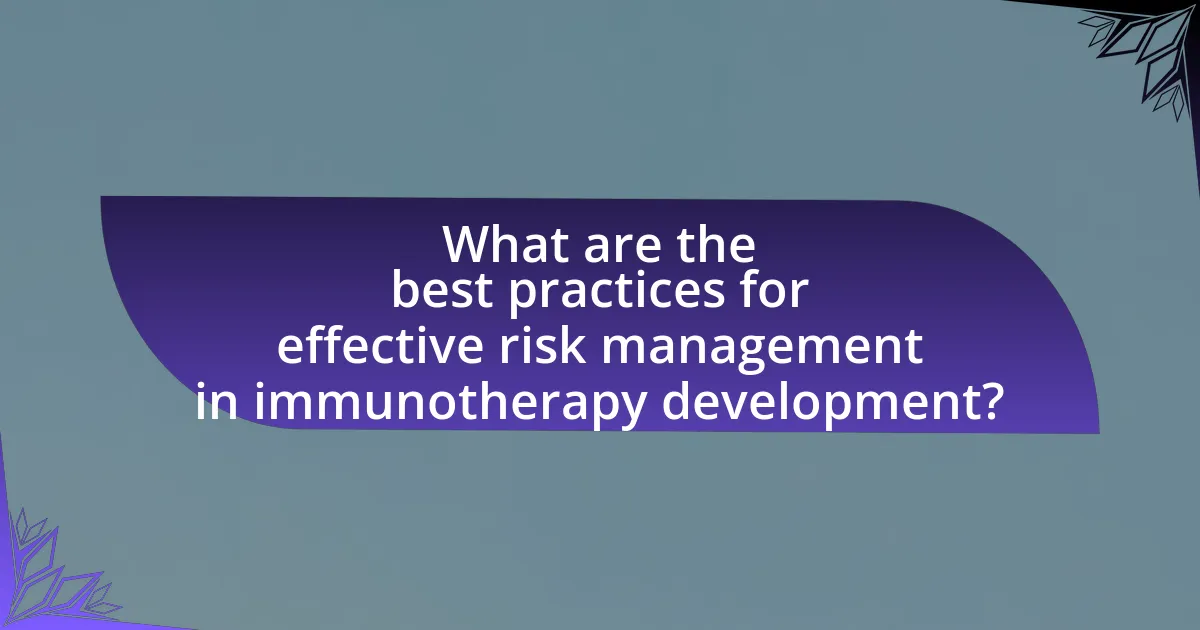
What are the best practices for effective risk management in immunotherapy development?
The best practices for effective risk management in immunotherapy development include thorough preclinical evaluation, continuous monitoring of clinical trial data, and robust stakeholder communication. Thorough preclinical evaluation ensures that potential risks are identified early, allowing for informed decision-making before advancing to clinical trials. Continuous monitoring of clinical trial data enables the identification of adverse events or efficacy issues in real-time, facilitating timely interventions. Robust stakeholder communication, including regular updates to regulatory bodies and investors, fosters transparency and trust, which is crucial for navigating the complexities of immunotherapy development. These practices are supported by regulatory guidelines from organizations such as the FDA and EMA, which emphasize the importance of risk assessment and management throughout the drug development process.
What strategies can enhance risk communication within teams?
Effective strategies to enhance risk communication within teams include establishing clear communication protocols, fostering an open culture for discussing risks, and utilizing visual aids for complex information. Clear communication protocols ensure that all team members understand their roles in risk management, which is essential for coordinated responses. An open culture encourages team members to voice concerns and share insights, leading to more comprehensive risk assessments. Visual aids, such as charts and graphs, can simplify complex data, making it easier for team members to grasp potential risks and their implications. Research indicates that teams with structured communication frameworks are 30% more effective in identifying and mitigating risks, highlighting the importance of these strategies in risk management for immunotherapy developers.
How can regular training improve risk management capabilities?
Regular training enhances risk management capabilities by equipping personnel with updated knowledge and skills necessary to identify, assess, and mitigate risks effectively. Continuous education fosters a culture of awareness and preparedness, enabling teams to respond swiftly to emerging threats. For instance, a study by the Project Management Institute found that organizations with regular training programs experience a 20% increase in project success rates, directly correlating to improved risk management practices. This evidence underscores the importance of ongoing training in developing robust risk management strategies, particularly in complex fields like immunotherapy.
What tools and technologies can assist in risk management processes?
Risk management processes can be assisted by tools and technologies such as risk assessment software, data analytics platforms, and project management tools. Risk assessment software, like RiskWatch or LogicManager, enables organizations to identify, analyze, and prioritize risks effectively. Data analytics platforms, such as Tableau or Microsoft Power BI, facilitate the visualization and interpretation of risk data, allowing for informed decision-making. Project management tools, including Asana or Trello, help in tracking risk mitigation activities and ensuring accountability. These tools enhance the efficiency and effectiveness of risk management by providing structured methodologies and real-time insights.
What lessons can be learned from past immunotherapy projects?
Lessons learned from past immunotherapy projects include the importance of early patient selection, the need for robust biomarkers, and the necessity of managing adverse effects effectively. Early patient selection has shown to enhance treatment efficacy, as evidenced by the success of checkpoint inhibitors in specific cancer types, which rely on identifying patients with particular tumor characteristics. The development of reliable biomarkers is crucial for predicting patient response, as demonstrated in studies where biomarker-driven trials yielded higher success rates. Additionally, managing adverse effects is vital, as seen in the high incidence of immune-related adverse events in clinical trials, which necessitates proactive monitoring and intervention strategies to ensure patient safety and treatment adherence.
How can case studies inform future risk management strategies?
Case studies can inform future risk management strategies by providing real-world examples of challenges and solutions encountered in immunotherapy development. These documented experiences allow developers to analyze past failures and successes, leading to improved decision-making processes. For instance, the case study of the CAR-T cell therapy development highlights the importance of addressing adverse effects and regulatory hurdles, which can guide future projects in anticipating similar issues. By examining specific outcomes, such as the efficacy and safety profiles of various therapies, developers can refine their risk assessment frameworks and enhance their strategic planning.
What are the key takeaways from successful immunotherapy risk management?
Key takeaways from successful immunotherapy risk management include the implementation of robust patient selection criteria, continuous monitoring of adverse effects, and adaptive trial designs. Effective patient selection enhances the likelihood of positive outcomes by identifying individuals most likely to benefit from treatment, as evidenced by studies showing improved response rates in targeted populations. Continuous monitoring of adverse effects allows for timely interventions, reducing the severity of complications, which is supported by data indicating that proactive management can decrease hospitalization rates. Adaptive trial designs facilitate real-time adjustments based on interim results, optimizing resource allocation and improving overall trial efficiency, as demonstrated in recent clinical trials that successfully adapted protocols based on early findings.
What practical tips can immunotherapy developers follow for effective risk management?
Immunotherapy developers can effectively manage risk by implementing a robust risk assessment framework that includes continuous monitoring and adaptive trial designs. This approach allows developers to identify potential safety and efficacy issues early in the development process, enabling timely adjustments to clinical protocols. For instance, utilizing adaptive trial designs can facilitate modifications based on interim results, thereby minimizing resource wastage and enhancing patient safety. Additionally, engaging with regulatory bodies throughout the development process ensures compliance and alignment with evolving guidelines, which is crucial for mitigating regulatory risks. Historical data indicates that companies employing these strategies have seen improved outcomes in clinical trials, underscoring the importance of proactive risk management in immunotherapy development.
